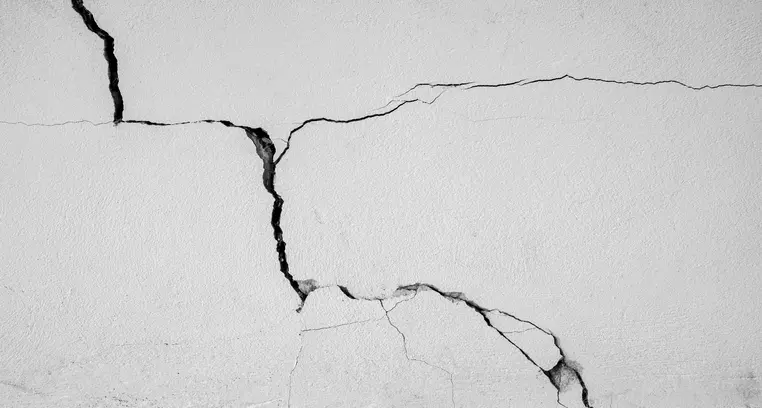Home Decorating Tips


Home Decorating Tips
4 Common Types of Cracks in Walls and What They Mean
Posted on July 14, 2025
Last updated September 1, 2025
At first glance, a small crack in the wall might not seem like a big deal — just a minor cosmetic flaw that may arise due to factors like expansion and contraction of building materials, improperly assembled drywall joints, poor plumbing and ventilation, and roof leaks.
However, a cracked wall is not entirely harmless, as it may signal deeper and more dangerous structural problems. If left unaddressed, even the tiniest of cracks can gradually worsen and compromise the safety and stability of a home. Before it’s too late, learn more about the different types of cracks that can be found in walls and what can be done to repair them.
Hairline Cracks
Considered the most common type of wall cracks, these are thin, web-like cracks that are typically less than 1 millimeter wide and resemble human hair. These cracks can go in any direction due to causes like:
- Concrete setting during the curing process may prompt shifts or movements that cause hairline cracks
- Minor changes to temperature and/or humidity can cause building materials like drywall or plaster to contract or expand
The good news is that hairline cracks are often superficial and may only require minimal repairs. However, some industry experts advise that hairline cracks be checked weekly to determine if they have increased in length or width, and that underlying issues that may have caused their appearance be addressed.
Vertical Cracks
As its name implies, this is a crack that runs from top to bottom. Much like hairline cracks, vertical cracks are not often concerning unless there are many of them in one wall (more on this to come later). Possible causes of the appearance of vertical cracks, which can vary in size, include:
- Improper seam taping between two drywall sheets
- Foundation settlement
- Temperature changes can make building materials slightly expand and contract
If a vertical crack is spotted, measure and see if it is more than 5 millimeters wide, especially if it is close to the ground. Should the vertical crack be located higher, mark each side and inspect it frequently to see if they have grown.
However, if multiple vertical cracks appear in one wall, especially on an exterior or foundation wall, these can be signs of a structural issue that may put the home at risk. At this point, a consultation with an industry professional (like an engineer) is crucial, as they can give insights on what went wrong and how to fix cracks in walls.
Horizontal Cracks
Horizontal wall cracks run parallel to the floor and should be repaired immediately, as they may indicate foundational issues or structural damage. Common causes include:
- Movement of the foundation caused by stress in the walls
- Poor soil conditions, moisture problems, or changes in water drainage surrounding the home that may lead to movement of the foundation and build-up of the foundation against the wall
Immediate horizontal wall crack repair is a must. If left unaddressed, the cracks can widen and lead to wall failure, regardless of their width. To prevent such cases from happening, talk to a foundation specialist or structural engineer upon spotting a crack. They can help determine the cause of the horizontal cracks and determine the ideal next steps to resolve the underlying issues.
Diagonal Cracks
These cracks are slanted at a 45-degree angle on the wall and usually begin at corners, window frames, and door frames. Diagonal cracks are caused by:
- Foundation settlement, wherein the soil pushes on a concrete basement wall
- Poor soil compaction that will unevenly settle as time passes, and increase stress on the walls
- Shifts in moisture content that may also cause uneven settling of the soil
- Poor drainage surrounding the house
Regardless of size, diagonal cracks should be assessed by a professional right away, as they often indicate foundational damage. Experts can help identify the cause and recommend steps to prevent further damage and strengthen your home’s structural integrity.
Don’t Let Cracks Turn Into Chaos — Learn How Here
Seeing any of these wall cracks can be stressful, even if some are minor. The good news is that many of them can be prevented early in the building process. Key preventive measures include building a strong, stable foundation, ensuring proper drainage and ventilation, and regularly maintaining the walls.
Of course, using high-quality materials is just as important — such products help reinforce and strengthen a home’s walls and foundation and reduce the chances of cracks forming over time. If you are on the lookout for items that will help ensure foundations and walls are less prone to cracking.
With Island Paints, you can prevent wall cracks from appearing and maintain the long-term stability of a home thanks to a wide range of safe and high-quality products that offer long-lasting durability and strength. Check out these home improvement and decorating tips that may provide additional information about fine-tuning a house’s structural integrity and preventing unwanted wall cracks and other issues.
References:
https://eppconcrete.com/cracked-walls-types-causes-fixes
https://www.a1concrete.com/concrete-repair-learning-center/concrete-crack-types
https://www.nar.realtor/blogs/styled-staged-sold/when-you-shouldnt-ignore-the-cracks-in-the-wall
https://amc911.com/wall-cracks-causes-repair-and-prevention/
https://www.constructionplacements.com/cracks-in-buildings/
https://www.constructionplacements.com/cracks-in-buildings/#Prevention_of_Cracks_in_Buildings
Our Products
Our line of high quality paints and products will give your home or project the vibrancy it needs.
Explore Colors
Ready to explore colorful possibiliies today? View our popular paint colo combination palettes for great color schemes and room design ideas for interior and exteriors.



